|
VARIANTS
Mk II was dropped into Denmark in several variants. The primary difference between the two basic models, the Mk II and Mk IIA, is the shape of the trigger and the trigger-guide. The Mk.II does not have the trigger-plate side plates (rails) to guide the trigger-plate but instead the trigger-plate is mounted with four screws through four milled slots in the trigger-plate to the bottom of the receiver. These slots serves the purpose of guiding the trigger-plate. Furthermore on the Mk II the ejector port scallop was ground along the length of the weapon (oval shape) whereas on the post #3300 series the ejector port has been ground perpendicularly to the length of weapon (angular shape).
The suppressor tube that is screwed onto the receiver is on the early model (Mk II) fixated with a pin on the side of the receiver, whereas on the later model (Mk IIA) it is fixated with a mandrel stamp on the top of the tube in front of the ejector port. Furthermore lesser variations can occur on both basic models as the changes were made currently. Typically these are things like the shape of the sights, or the way the suppressor was "packed", the number of spacers and bafflers etc. It should be noted that other variants than the above-mentioned can occur as these descriptions only adhere to the Welrods I have had the opportunity to study. The alterations were solely made for reasons of production and had no influence on the functionality or use of the pistol.
According to a document from The Public Record Office, the Welrod was, in both 9mm and .32ACP, tested along with 76 other devices during the period October 1. 1943 - October 10. 1944. Both versions received a "B" grading meaning "substantial modifications needed". It is tempting to assume that these modifications resulted in the change of designation from Mk.II to Mk.IIA, especially since the drawing of the Mk.IIA recently discovered, is dated September 6. 1943 and marked with the trademark: B.S.A. GUNS LTD, England. In other words the Mk.IIA was still under development during the trial. Sadly the character of the modifications was never specified in detail why the question remains unanswered. According to the drawing the last revision was made August 8. 1944.
Welrod Mk I (9mm Parabellum) was equally produced in at least two variants "Type A" and "Type B". I have not been able however, to define with certainty the difference between the two.
DESCRIPTION OF Mk. II AND Mk. IIA
On the exterior the pistol consists only of the tube which, including the breech, measures 12.2 inches. On to the tube is fitted an app. 1 inch magazine housing. The housing fits a modified magazine from a Colt Pocket Model 1903 .32 ACP pistol. The modification consists of a little locking mechanism soldered onto the back of the magazine. When inserted into the magazine housing, the mechanism locks into a little square hole on the back of the housing. The magazine, sheathed in rubber (Ebonite), doubly functions as the pistols grip. Unfortunately this system turned out to be inexpedient, as the operator in extreme cases risked accidentally activating the locking mechanism thus ejecting the magazine. The safety of the pistol is a so-called grip safety. When a firm grip is maintained around the pistol grip the grip safety will be activated and lift the safety bar that blocks the trigger plate and the weapon can be fired. The safety works by mechanically blocking the action of the trigger but not that of the firing pin. The trigger, best described as a bent nail, is contrary to the Mk I not protected by a trigger-guard, meaning that it cannot simply be tucked into the belt without risking involuntarily to release a shot. The sights are basic front and rear with ability to horizontally adjust the rear sight. The pistol weights 2.4 lb.
Even though the magazine holds 8 rounds the manual recommends the loading of 5 rounds maximum in order to ensure a reliable feed of the chamber upon reloading. The Mk II's are bi-coloured in that the receiver is brownish. The Mk.IIA pistols appears well made, sturdy of construction and without lavish detail. It is parkerized and the finish appears steely grey. The rubber magazine is black. With the magazine off, the pistol can pass for almost anything. It was quickly dubbed "The bicycle pump" due to its anonymous appearance.
Several of the Mk IIA's and Mk I's inspected bear semblance of having been painted black. Several areas still have paint residue around the trigger, trigger-guide and magazine housing. If they actually at some point in time were black or the reason is another, I have not yet been able to determine.
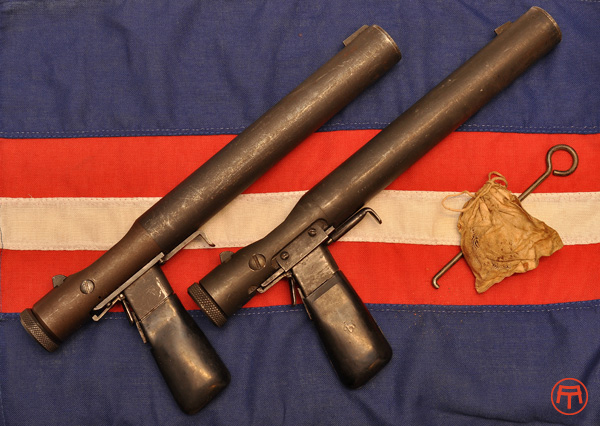
Here can be seen an original washer set consisting of three linnen/rubber washers in a canvas bag. Note the special extractor tool under the bag. The pistols is a Mk.II on the left and a Mk.IIA to the right.
FUNCTION

The pistol is a single-shot weapon but since it is operated and basically functions as a bolt-action rifle it is possible to repeat relatively fast. This is accomplished by twisting the knurly end of the breech 90 degrees counter clockwise and pull it back approximately 1.5 inch till it reaches the stopping-screw. Hereby the empty cartridge is extracted and ejected vertically as with the Luger P. 08. The breech is then pushed forward, peeling a round of the magazine and feeding it into the chamber, and at the same time cocking the firing pin.
The pin is of the "floating" kind, as we know it, among others, from the Luger P.08 and basically functions in the same manner. To lock the breech, this is now twisted 90 degrees clockwise and the pistol is ready to fire. The breech has its two locking lugs placed to the rear, as opposed to modern rifles where the lugs are placed in front of the breech head. As there is no protruding grip on the breech, you can visually verify the correct locking by checking that the purpose made V-shaped notch on the knurly part is aligned with the V-shaped notch in the receiver just behind the rear sight. For cleaning or maintenance the stop-screw is unscrewed with a coin or similar, allowing the breech to be extracted from the receiver.
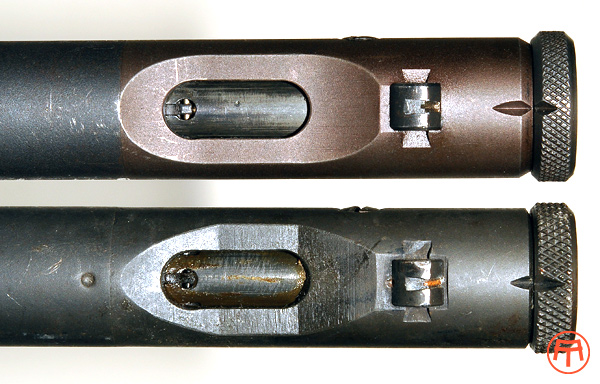
Here is shown the two V-shaped notches in the breech and the receiver respectively. The notches must be aligned to ensure correct locking of the breech. Note Mk II (above) has more of an oval shaped ejector port scallop as opposed to the Mk IIA (below) that is angular.
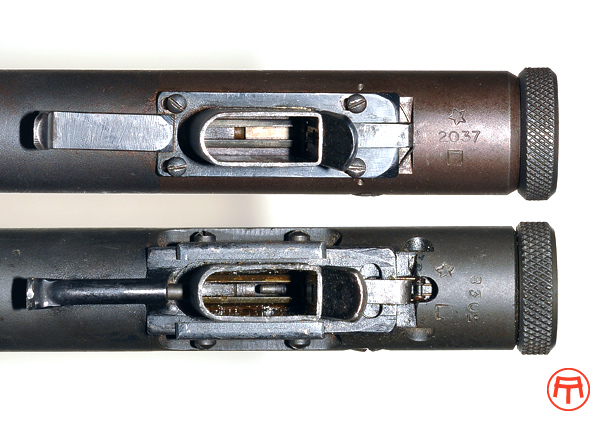
Here can be clearly seen the differences in the trigger-guide and the trigger shape along with its spring mechanism. Mk II (above). It is also clearly visible how the grip safety bar blocks the trigger platform to prevent unintended activation (click for larger photo).
Keeping in mind the purpose for which it was built, it is obvious why the Welrod had no place on the open battlefields. This statement is supported in the English manual from December 1943 where the reason for the shape of the nose cap is given as follows:
The nose cap of the weapon is hollowed to enable an operator to place it tightly against the body of a person and fire. The noise is then still further reduced. This will allow the shooting of a man in a crowd with the minimum chance of detection. For this purposes, there is no question of any special training.
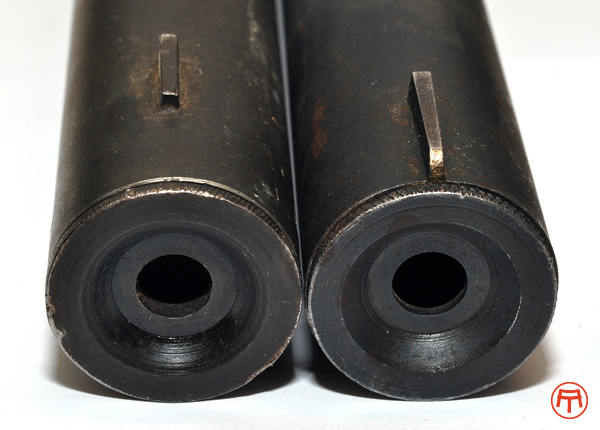
Here can be seen the particular shape of the nose cap that is being referred to in the manual.
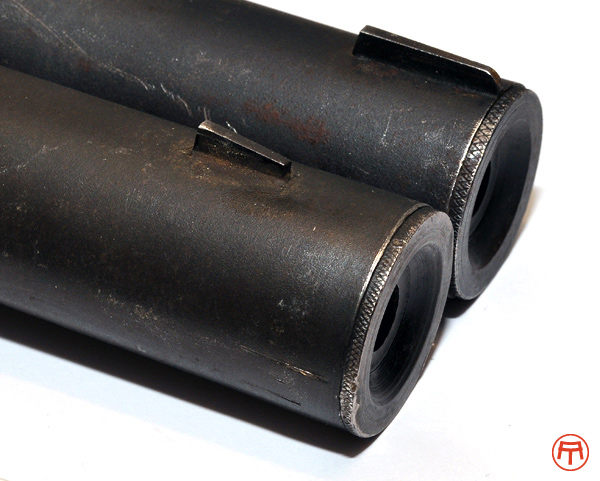
Mk II (above) was fitted with a disproportionately long foresight compared to the later Mk IIA (below).
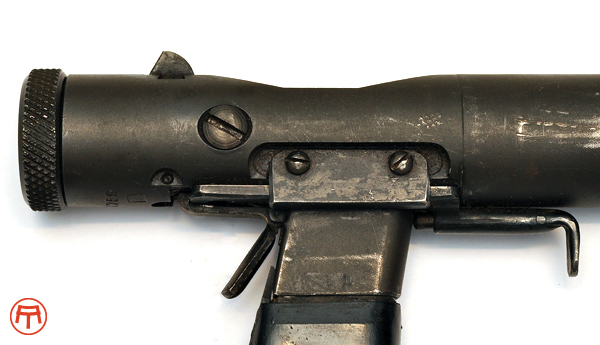
Here can be seen the stopping-screw that ensures that the breech is not extracted from the receiver during the loading procedure. Note the rails guiding the trigger.
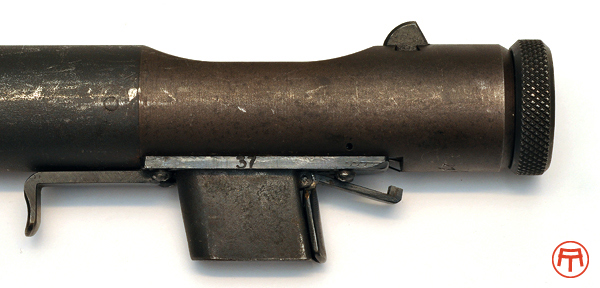
Only on the first few models the two end-digits "37" of the serial number was stamped into the trigger platform.
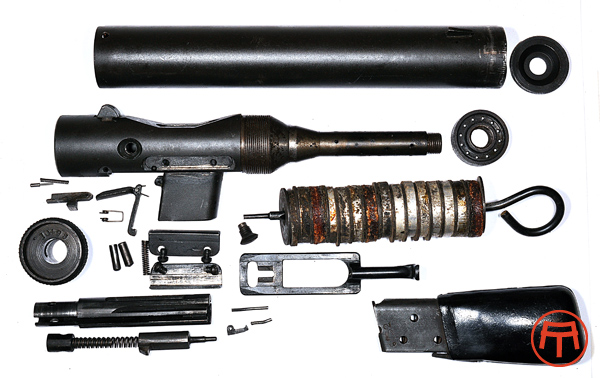
Welrod Mk IIA dismantled. Note the barrel bearing with the 12 vents as well as the insides of the silencer here shown exactly as it was packed. The magazine well has been forced into a milled out hole in the receiver and then silver soldered for permanent fixation. The barrel has been fixed to the receiver with a pin.
In the same manual the effective range in daylight is given to be 25 yards, and in darkness - hence the fluorescent coating on the sights - 7 to 10 yards. The manual does however recommend that the operational distance be kept to within 8 yards. A prerequisite for shooting at 25 yards is explained as follows:
For these deliberate shot, extreme accuracy is required. It can only be obtained by correct trigger squeeze, that is by gradual squeeze of the whole hand. With training and practice it will be found quite possible to get very accurate groups at the distances mentioned. The gun should be held with the thumb and forefinger as close up to the muzzle as possible, the pistol grip being held by the right hand no harder than is necessary to compress the safety catch. For standing shots, the left elbow should be held as close in to the body as possible.
|